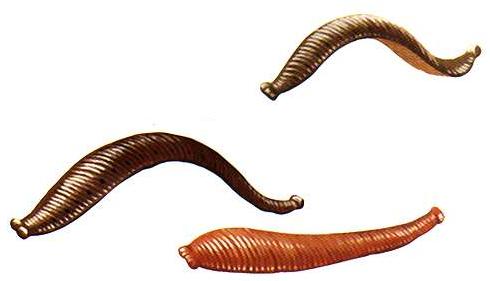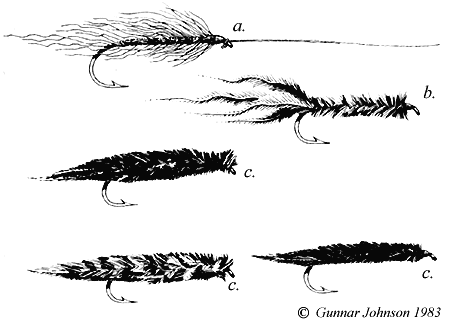
Leeches...
...disgusting for us,
but the rainbow thinks different.
By Gunnar Johnson

Several of the fish I caught during the latest seasons have had
their stomachs full of leeches. My fellow fly fishing friends have made the same
discoveries. I don’t know if this has been coincidence or if the leeches have
multiplied in my waters. Or - ugly thought - maybe the salmon’s other prey have
disappeared because of the acidification effects and the fish now have switched to a
different menu. If some animals are wiped out, consequently others will fill the niche.
The leeches are, according to the
dictionary, grouped with the Annelids, which also makes them related to both earthworms
and sea chaetopods. Both of them are popular on the menu of the trout. There are several
different leeches in streaming and still waters. They all are long, slightly flattened and
worm-like animals that swim with winding, wavelike movements. The color on the ones
I’ve seen has varied. Most of them have been dark gray-brown or black. Others have
been pure brown, often slightly olive. Some have been mottled or spotted and all have been
slightly lighter on their underside.
Most known is probably the
"Medicinal leech", Hirudo medicinalis, that has been used in the
medicine. It’s the sight of this one and the thought that it will get attached to us
and suck our blood that makes us shiver when we see them. Luckily not all leeches are this
unpleasant. The medicinal leech is also quite uncommon in Scandinavia. Most common are the
"Horse leech", Haemopis sanguisuga and "Dog leech" Erpobdella
octoculata and the fish doesn’t mind getting fat eating these. Especially the
rainbow is fond of them.
I first hesitated when I discovered the
use of the leeches as fish food. I didn’t exactly feel any joy when I started
experimenting with the tying. However, my test fishing showed me large fishes - larger
than average for my water - and that is why I now always will carry some leech patterns
with me. For a start they will be my "rescue-line", that I only use when nothing
else helps.
One of the patterns I have tried is a
leech made by cut marabou. This is the same method that for example Clayne Baker uses.
Personally I think this is a superior technique when it comes to creating a lively
representation of the leech. The soft marabou fibers move and breathe. At first I had
trouble getting my marabou leeches to sink properly and I’ve heard the same critique
from others fishing with Clayne’s large dragonfly nymphs. We both try to avoid to
make or flies heavy because they get a better and livelier movement if the hook is not too
heavy. Clayne has taught me to dip the fly into the water before I start fishing. At the
same time I squeeze out all the little air-bubbles stuck in between the fibers.
You should also throw with soft movements
and a larger line loop than normal. This way you don’t splash out as much water from
the flies. In other words the same throwing technique that you would use when you’re
fishing with dubbed and hackled nymphs, to make sure they will sink below the surface
quickly. It’s important not to have too much speed or too narrow line loop that will
cause the fly to turn too quickly and loose all the water. Instead try to make the fly
retain as much water as possible during the blind throws. This will cause it to sink
easier next time it hits water.
At an earlier time, stiff rods were
considered dry-fly rods while the nymph-rod should be slower and throw with a softer loop.
As important as it was to dry the dry-fly in the blind throws, just as important it is to
make sure the nymphs with their hairy water retaining bodies keep their water. The same
goes for these "leech-flies".


a. Leech
tied with combed mohair yarn.
b. The hook shaft wrapped with marabou and a tail of the same material.
c. Clipped marabou leeches, made by the Clayne Baker’s method.

Not many years ago we anglers
"discovered" how to fish with midges-- and caddis pupae. This type of fishing
didn’t become popular until the 1970’s. Today we know that it’s a prey that
is highly valued on the fish’s menu. Certain times of the year and in certain waters
it may even be the dominant food. Despite this fact, many generations of fly-fishers
completely overlooked the importance of these insects. Maybe the same goes for the
leeches. Although here we have yet another step to climb considering that leeches hardly
can be described as pleasant and most of us have an aversion towards them. Additionally
they are large and usually tied on a streamer hook.
Both I and a few of my fishing friends
have asked ourselves if this still is considered fly-fishing or not. Technically it is -
the fishing is performed with a fly fishing rod, a fly reel and a feathery tied hook
representing one of the fish’s prey. But there’s also an emotional aspect of
fishing this way with these flies. I think it can never be compared with the light fishing
with a dry-fly or a nymph on the tippet. As Jim Leisenring once said: "We all fish
for our own enjoyment - me for mine and you for yours", nobody can say what is right
and what is wrong.
But there are some that knows for sure.
The rainbow and the trout. Both have shown that they appreciate the leeches and we may
have to surrender to that - whether we like it or not.
Short section from my fishing
diary:
…drove a short trip to Haga at
around 10.00. Roger was already there and he was just reeling in a one kilo rainbow as I
arrived. This is his third salmon for today he says, and they’re all caught with a
sinking line down at the bottom. He keeps the last one and together we gut it and check
the stomach content.

The entire stomach is filled with leeches
of the same kind we have found that many rainbow have been eating in our other waters
since two years back. They are apparently very attractive to the rainbow - this one even
specialized on them… |